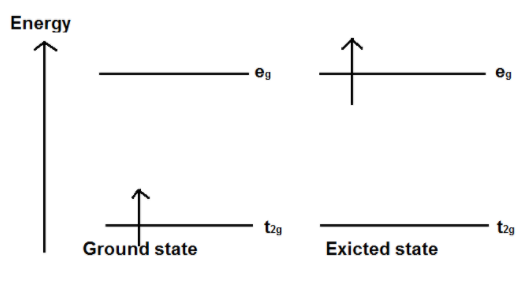
Explain the violet color of \[{\left[ {{\mathbf{Ti}}{{\left( {{{\mathbf{H}}_{\mathbf{2}}}{\mathbf{O}}} \right)}_{\mathbf{6}}}} \right]^{{\mathbf{3}} + }}\]complex on the basis of the Crystal Field theory?
Answer
555.3k+ views
Hint: In the given question we will discuss how the change of the color of the complex occurs on the basis of the crystal field theory. The CFT is a theory which is used to describe many spectroscopies of transition metal coordination complexes, in specific optical spectra that are colors.
Complete answer:
In the Coordination compounds they exhibit color, which is credited to the crystal field theory, that corresponds to the \[d - d\] transition of the elements. In ground state, the complex of Titanium has \[23\] electrons which have the outer shell electronic configuration that is \[3{d^3}4{s^2}\] and in the complex it is observed that titanium is in its \[ + 3\] oxidation state. This is accomplished by losing \[3\] electros. So, it has the configuration \[3{d^2}\]. Since it has \[2\] unpaired electrons and has the ability to undergo \[d - d\] transition, thus the complex is colored.
When light corresponding to the energy of the yellow-green region is absorbed by the complex, this would excite the electron from\[\;{t_{2g}}\;\] level to the \[{e_g}\;\] level. Thus, the complex occurs in violet color.

Figure 1 transition of electron in Ti complex
As though in the absence of ligands there will be no crystal field splitting and substance become colorless. when water molecules are removed it becomes colorless.
Note:When the excitation of an electron takes place from the ground state to excited state, electrons will absorb light that will excite the electron from one energy level to another and will return to ground state in the form of colors.
Complete answer:
In the Coordination compounds they exhibit color, which is credited to the crystal field theory, that corresponds to the \[d - d\] transition of the elements. In ground state, the complex of Titanium has \[23\] electrons which have the outer shell electronic configuration that is \[3{d^3}4{s^2}\] and in the complex it is observed that titanium is in its \[ + 3\] oxidation state. This is accomplished by losing \[3\] electros. So, it has the configuration \[3{d^2}\]. Since it has \[2\] unpaired electrons and has the ability to undergo \[d - d\] transition, thus the complex is colored.
When light corresponding to the energy of the yellow-green region is absorbed by the complex, this would excite the electron from\[\;{t_{2g}}\;\] level to the \[{e_g}\;\] level. Thus, the complex occurs in violet color.

Figure 1 transition of electron in Ti complex
As though in the absence of ligands there will be no crystal field splitting and substance become colorless. when water molecules are removed it becomes colorless.
Note:When the excitation of an electron takes place from the ground state to excited state, electrons will absorb light that will excite the electron from one energy level to another and will return to ground state in the form of colors.
Recently Updated Pages
A man running at a speed 5 ms is viewed in the side class 12 physics CBSE

The number of solutions in x in 02pi for which sqrt class 12 maths CBSE

State and explain Hardy Weinbergs Principle class 12 biology CBSE

Write any two methods of preparation of phenol Give class 12 chemistry CBSE

Which of the following statements is wrong a Amnion class 12 biology CBSE

Differentiate between action potential and resting class 12 biology CBSE

Trending doubts
What are the major means of transport Explain each class 12 social science CBSE

Which are the Top 10 Largest Countries of the World?

Draw a labelled sketch of the human eye class 12 physics CBSE

Explain sex determination in humans with line diag class 12 biology CBSE

Explain sex determination in humans with the help of class 12 biology CBSE

Differentiate between homogeneous and heterogeneous class 12 chemistry CBSE




